Numerous inventions of the 19th - early 20th centuries radically changed ...

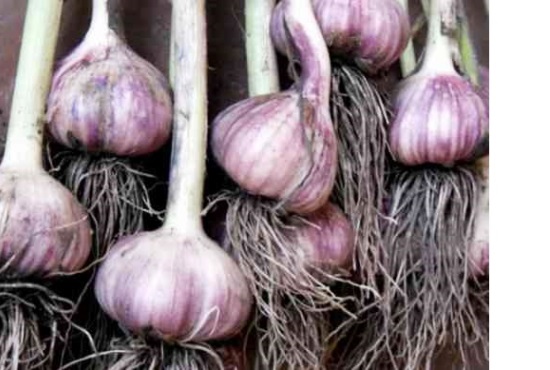
A famous proverb advises us to prepare a sled in the summer, but summer residents begin to work with beds at the end of the season. Then, with the advent of a new planting period, you can hope for a good harvest. Preparing the beds for the process is simple, but you will have to try to get a good harvest.
It is recommended to prepare the beds for garlic about a month and a half before planting. It is difficult to name specific dates, since in each region the cold comes in different ways. But most often this period falls at the end of summer - the beginning of autumn. Your task is to track the weather forecasts in the region, and choose the time when there will be about a month left before the permanent cold weather. It is dangerous to start planting earlier, as the seeds may hatch.
According to the scheme above, you need to prepare a bed for garlic in the fall, then properly dig everything to a depth of at least 20 cm. Digging is followed by leveling with a rake and tamping. It is important during the preparation of beds for winter garlic to thoroughly clean everything from the weed and constantly monitor this moment. Then in early spring all your efforts will not be crossed out by the rapid growth of weeds, and the harvest will be of high quality and good quality.
Garlic has many useful properties, every summer resident grows it.
However, not everyone manages to get a good harvest.
In order to have excellent teeth in the summer, you need to properly plant garlic in the fall.
And you need to start with the choice of planting material, preparing the beds and much more.
To begin with, the gardener must decide what kind of garlic he wants to grow. The fact is that this culture is divided into several types:
Spring garlic;
Winter garlic.
These species differ from each other externally in the number and shape of teeth.
1. Winter garlic cloves are large, the same size. They are evenly distributed around the base in one row.
2. Varieties of winter garlic give a flower arrow that forms bulbs.
Winter garlic is dug up early, used for summer consumption or for harvesting. For longer storage, varieties of spring garlic are grown. This article will focus on the cultivation of winter garlic.
Some gardeners prefer to grow spring garlic as it has a longer shelf life. However, there are a number of advantages to planting winter garlic.
1. Saving time during spring work. The landing dates are extended, which allows you to take your time and prepare well for the procedure. In the spring there is too much work in the garden, there is no time for high-quality preparation of beds and material, and in autumn it is much more.
2. Winter garlic is not afraid of frost, while return frosts can destroy the tender shoots of spring garlic.
3. Planting material is quite large, and a small fraction of spring garlic often dries out by the time of planting.
4. Winter garlic is undemanding in care, since soil moisture is sufficient for its development.
5. Winter varieties of garlic are more resistant to pests, less affected by various diseases.
6. The yield of winter garlic is much higher than that of spring garlic.
7. Harvesting takes place a month earlier, which allows garlic to be used for summer consumption.
An important factor on the way to harvest is the variety that is cultivated on the site. Experienced summer residents prefer purple-striped varieties of garlic. In the people they are called so for the color of the scales. Indeed, these varieties are the most resistant to disease and frost. Commodity quality heads at the highest level. Bulbs are formed weighing about 150 grams each.
Gribovsky Jubilee;
Komsomolets;
Polessky;

An experienced gardener knows that you can only get a good harvest only when the planting is done on time. Many people confuse the types of garlic and plant them at the wrong time, which reduces the quality of the crop and its quantity.
For an early harvest, planting of winter garlic is carried out in the fall. If it is planted in the spring, then the teeth will not tie, but lush, green tops will grow. The formation of a commodity head occurs under certain conditions.
Autumn dates winter landing garlic for each region will be different, but following some rules will help you accurately determine the auspicious time.
1. It is better to plant the prepared material a month before the expected frost. It takes about 3 weeks for the teeth to root.
2. Under the conditions of the middle zone, the period of autumn planting of garlic falls on the end of September - the beginning of October. In a month, the teeth will form a powerful root system, which is the key to a bountiful harvest.
Cold and frost are not terrible for garlic if the root system has developed sufficiently, but a late planting leads to the fact that the roots are poorly formed. This leads to the fact that the teeth will die in the winter.
Important! You should not rush into planting too much; winter garlic should not be allowed to germinate in the fall.
The harvest of the next year also depends on the quality of the teeth. All planting material undergoes strict processing and preparation.
For planting, well-dried heads are chosen, which are carefully divided into teeth, trying not to damage the scales.
The selected material is sorted. The teeth must be healthy, with no visible signs of disease, stains, cracks or injuries. Spoiled teeth will rot and can infect the entire garden.
It is better to plant those varieties that are cultivated in the region. This will provide a more stable harvest.
All teeth are pre-treatment. Garlic is soaked for several minutes in a salt solution. To do this, add 3 tbsp to 5 liters of water. tablespoons of table salt.
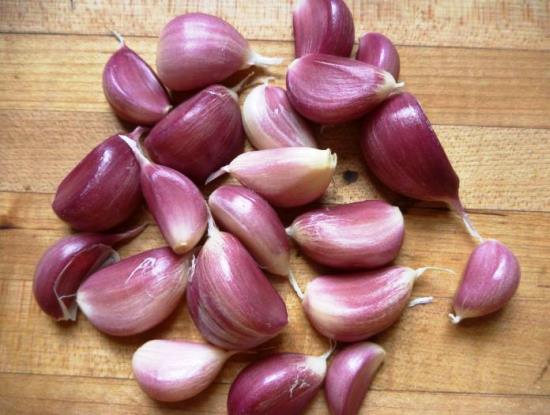
Advice! If you want to grow a crop of large garlic, then only large cloves are selected for autumn planting.
Experienced summer residents for disinfection of planting material use a solution of potassium permanganate, the drug "Fitosporin-M", ash infusion. Prepared and sorted teeth stand for about 30 minutes.
Another factor affecting yield is the soil in which garlic is grown. The quality of the resulting heads directly depends on its structure and composition. Therefore, special attention should be paid to soil preparation. What does it mean?
1. The bed for the autumn planting of garlic is prepared in advance. As a rule, a month before the intended landing.
2. Too dense soil is not suitable for growing garlic, so it must be loosened.
3. The ideal soil for garlic is loam.
4. A good harvest is obtained only in a land rich in nutrients. Fertilizers will help improve the composition of the soil.
The amount and type of fertilizer depends on the soil in which the cultivation is planned. Mineral complexes are introduced into loamy soil for digging. For 1 sq. meter:
1 glass of dolomite flour;
1 st. a spoonful of superphosphate;
1 st. spoon of nitrophoska
You can enrich the soil with organic fertilizers. Suitable humus or compost, one bucket per 1 sq. m. beds.
Other types of soil fertilize differently.
1. Clay soil is enriched with peat. 1 bucket per 1 sq. garden meter.
2. Peatlands are bred with loamy soil.
3. Sandy soils need fertilizers like loams, but with the addition of peat.
All fertilizers are applied under the digging of the beds. It is necessary to loosen the earth to a depth of 20 cm. After that, the landing site is formed and compacted.
The finished bed is watered with a disinfectant solution. For this, copper sulfate is used. In 10 liters of water, dilute 50 gr. drug. The bed is watered and covered with a film until planting.
Light and loose earth, which is enriched with nutrients, allows you to grow large and healthy garlic.
A garden bed with garlic is best placed in a well-lit place. This culture does not like stagnant water, excessive moisture contributes to the development of fungal diseases. If there is no other place, then you can correct the situation by arranging high beds.
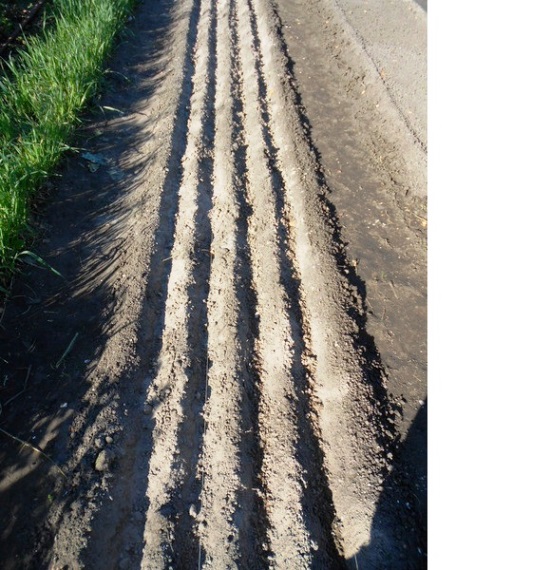
Most often, garlic is grown in rows in the garden. The distance between them is about 25-30 cm, which makes it easier to care for the culture. The teeth are planted in rows at a distance of about 10 cm from each other. However, this depends on the size of the planting material. Larger cloves need more space, while smaller ones can be planted more tightly.
The depth of planting the cloves depends on the period of planting the garlic. In autumn, furrows are made deeper for winter sowing, about 10 cm. Insufficient planting depth will cause the garlic to freeze. In harsh climates, gardeners practice mulching the beds with straw or dry grass. However, in early spring, the shelter must be removed.
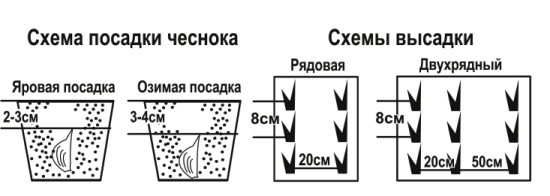
Furrows for planting are made parallel to each other, and the teeth are planted strictly vertically, bottom down. There is nothing difficult in the formation of beds, adhering to all the rules, you can expect a good harvest next summer.
1. After processing, planting material must be planted immediately. If this is not possible, then it is better to store it for no longer than a week. Further, the percentage of germination of teeth decreases.
2. Experienced gardeners know how the proximity of crops in the garden affects the yield. The best precursors of garlic are greens, root vegetables, cucumbers, tomatoes, eggplant, cabbage and zucchini. You can grow garlic in the same garden as strawberries, cucumbers and tomatoes.
3. You can not plant garlic after onions. You can return the culture to its original place after three years.
4. Strict adherence to the timing of winter planting garlic in the fall.
5. High-yielding proven varieties are selected for planting. Do not expect a good harvest from a low-yielding variety.
6. Timely updating of planting material. Garlic, like any other culture, gradually degenerates. Once every three years, you need to rejuvenate the variety. To do this, leave a few arrows, from which bulbs are obtained. In the first year, single teeth grow from them. Having landed single-toothed teeth in the fall on the garden, in the summer they get commodity heads.
7. Compliance with the terms of harvesting. They differ in each region. You can determine the exact time using the arrow. As soon as it burst and bulbs appeared, the garlic ripened.
8. Breaking out the arrows allows you to grow larger heads of garlic, speeds up the ripening process.
9. Compliance with the exact mode of watering. In the first phase of growth, winter garlic is watered abundantly, and by the end of the growing season, watering is stopped.
10. Mulching beds with garlic favorably affects the formation of heads. Mulch helps to retain moisture, which is necessary for the formation of large teeth.
Advice! If the beds are cleared up in the second half of June, this contributes to the formation of a more even and larger head.
Despite all the tricks, growing large garlic without the necessary dressings will not work. During the growing season, winter garlic needs to be fed several times.
The first feeding is carried out at the beginning of the growing season, when the first leaves appeared. During this period, nitrogen fertilizers are used. Experienced gardeners water the bed with infusion of mullein or chicken manure. In 10 liters of water insist 1 kg of the substance. After the completion of the fermentation process, the solution is diluted with water in a ratio of 1:10, 10 parts of water are taken for 1 part of the infusion.
The second top dressing is carried out at the time of head formation. The same solution is used.
Harvesting must take place at a certain time, which affects the quality. Winter garlic is dug up when the leaves begin to turn yellow. Loosen the bed with a pitchfork, carefully removing the garlic. The harvested crop is shaken off the ground and dried.
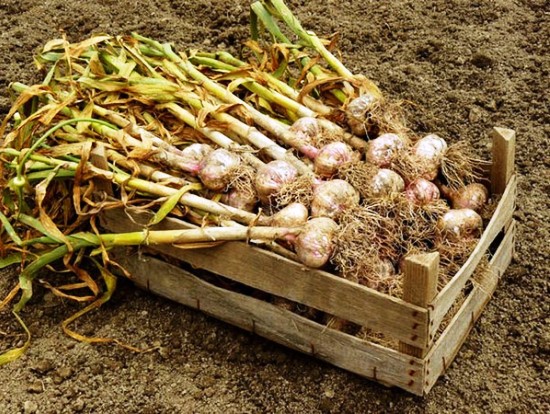
You need to dry the garlic in the shade under a canopy. Stems and roots should not be cut off. They should dry on their own. During the drying process, all the nutrients from the stem descend into the head. During the drying of the crop, it is periodically inspected and ted. Particular attention is paid to the lower layers, as they can flow.
When the garlic is well dried out, the stems are cut to a height of 10 cm, the remnants of dry roots are removed and the heads are stored for storage. In this form, the crop is stored until planting.
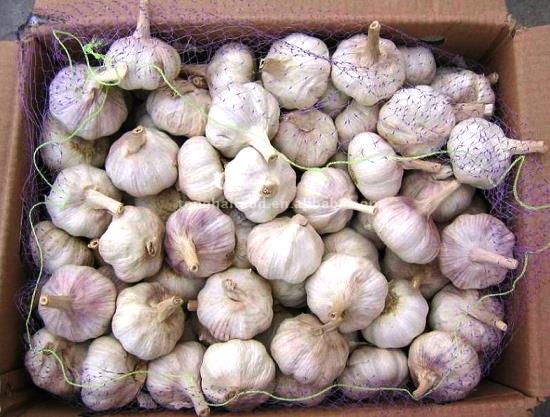
In conclusion, we can say that garlic is an unpretentious culture. Its cultivation is not a hassle, but it is imperative to take into account all the above rules to get a good harvest of winter garlic.
Feeding garlic is one of the important procedures. This plant consumes a large amount of nutrients from the environment. Deficiency of any of the elements will adversely affect the yield of the plant. In order for the garlic in the beds to look healthy and beautiful, it is necessary to periodically apply appropriate fertilizers. It is also important to know how often to process and what to use for this.
Winter garlic is considered a moisture-loving and frost-resistant crop. It is susceptible to increased soil acidity. These characteristics must be taken into account when introducing fertilizers into the soil.

Winter varieties of garlic are recommended to be fed both in spring and in autumn. 3-3.5 weeks before planting, fertilizer is required to be applied to the soil. The nutrient is humus. Even in small volumes, wood ash, compounds with phosphorus and potassium are introduced. Such products should be introduced while digging the soil. Additionally, after the end of planting work, manure is spread on the beds in a rotted form.
You can also improve the composition of the land in which garlic is planted in a different way before the onset of winter. When growing garlic in open ground, which is clayey and heavy, it is necessary to add 10 liters of coarse sand and peat for each square meter. If peatlands are present, then, on the contrary, 10 liters of loamy soil and the same amount of sand per square meter will be required. If the site has light sandy soil, then you will need to use 10 liters of peat and loamy soil for each square meter.
When the land is improved in this way, additional fertilizer is required when planting. For each square meter, it is recommended to add 10 liters of humus, 0.2 liters of ash, the same amount of dolomite flour. You can use 30 g of potassium sulfate and 15 g of double superphosphate. If necessary, humus is replaced with compost, which has managed to overheat. Instead of potassium sulfate, you can use any fertilizer with a high content of potassium. Dolomite flour can be replaced with ordinary chalk. Ash is better suited from deciduous trees. If garlic is planted on fertile black soil, then organic fertilizers can be dispensed with. The same applies to cases when manure was introduced into the soil to grow the previous crop before garlic.
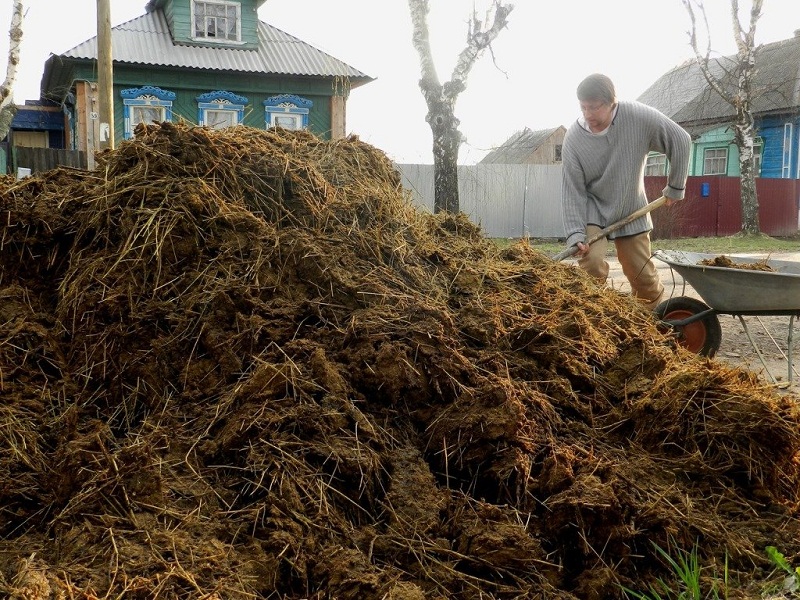 Some experts believe that winter garlic should be fertilized with compounds with a high nitrogen content. This will allow him to better settle down and adapt. Many people use ammonium nitrate because of this. But this method is considered very dangerous, since there is a high probability of oversaturation of the substrate with nitrogen. Because of this, the first shoots will have time to appear before frost, which will simply freeze in winter. The necessary amount of nitrogen is already present in organic products that were used when digging the soil in the fall.
Some experts believe that winter garlic should be fertilized with compounds with a high nitrogen content. This will allow him to better settle down and adapt. Many people use ammonium nitrate because of this. But this method is considered very dangerous, since there is a high probability of oversaturation of the substrate with nitrogen. Because of this, the first shoots will have time to appear before frost, which will simply freeze in winter. The necessary amount of nitrogen is already present in organic products that were used when digging the soil in the fall.
Even if such products have not been used, do not rush to use nitrogen-containing substances. They are brought in only if the planting was untimely, and it is necessary to have time to awaken the cloves before the onset of winter (they must have time to take root). This method is suitable for the northern regions, where there is very little time in summer and autumn. You can use urea. For each square meter, 10-20 g of product will be needed. Carbamide must be used with care.
Top dressing in the spring should be carried out according to a certain scheme:
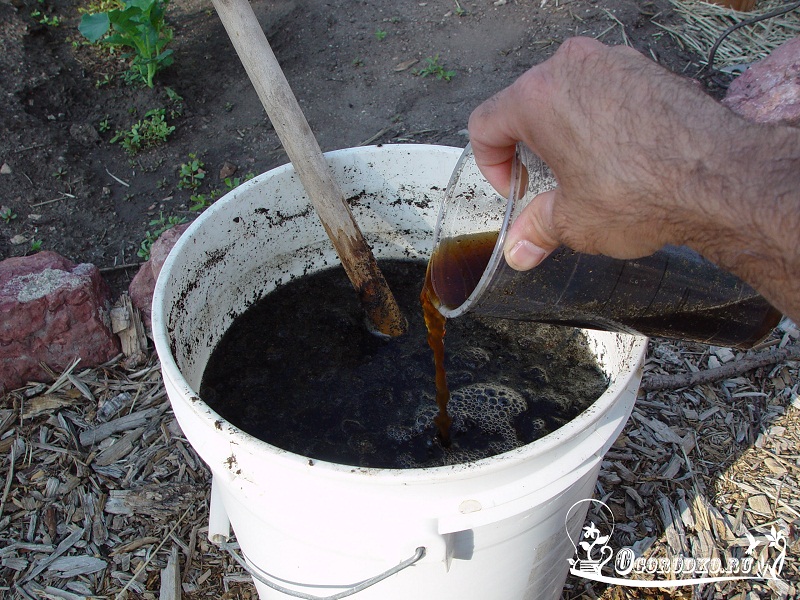 Also in the spring you can use other products:
Also in the spring you can use other products:
For winter crops, it is better to carry out the first spring top dressing 1-1.5 weeks after the snow has melted on the beds. But for spring, the situation will be different. Since such a crop is planted only in spring, fertilizers should be applied at a later time. The guideline is the activation of growth and the appearance of ovaries. The last top dressing will also differ in time for spring and winter crops, since they form and develop in different ways.
Garlic does not withstand overflows and stagnant water, so in the spring it is necessary to fertilize along with watering. Organics are recommended to be used less frequently, as it can provoke the appearance of fungal diseases. If the soils are depleted (lack of humus), then you can use mineral compositions containing humates. Top dressing to carry out on a leaf or under a root.
Foliar feeding is an additional measure when the crop lacks nutrients. For example, if the tops begin to lighten, then a lack of potassium affects. You can use ash or potassium salt. If the tops begin to turn yellow and dry out, the cause is considered to be a lack of nitrogen. It is recommended to use urea.
Many farmers prefer to use and folk remedies. When the tops begin to turn yellow and dry, this means that the plant is deficient in nitrogen. But the additional use of chemicals can lead to the accumulation of nitrates. In this case, you can resort just to improvised means, which also have proven themselves well.
You can use the following products:
![]()
Additionally, the sideration method is also used. It involves the cultivation of garlic along with crops that will not only enrich the soil with useful substances, but also prevent the appearance of pests. They trap snow and help root crops survive severe frosts. Usually white mustard is used. Legumes include peas and beans. Green manure crops for garlic can also be cereals - rye, oats, wheat.
When using green manure, the soil must be prepared in a standard way. It is necessary to dig it up and lay organic and mineral fats. Additional treatment with copper sulphate is not required. The beds need to be watered and green manure crops planted. Sowing should be carried out in a belt way next to the holes for garlic. When sprouts appear and their height is at least 20 cm, garlic can also be planted.
Garlic is one of the popular crops grown in suburban areas. This is not surprising given its health benefits and worldwide popularity as a condiment. Every gardener dreams of a good harvest of garlic, but not always gets it. The most logical way to solve this problem is to fertilize the beds in a timely manner with substances that will help the plants become stronger and larger. But here it is very important to observe the dosage, the number of dressings and the time of their application. In addition, garlic can be winter and spring, and their fertilizer has its own characteristics. This is also a kind of science, and it must be comprehended.
Given that winter garlic is planted in the fall, at this time it needs to be fed to provide a supply of all the necessary substances for the winter. And in the spring, after the experienced cold season, the plants all the more need vitamin help in order to produce an excellent harvest over the next few months. Thus, the application of fertilizers makes it easier for the crop to survive the cold winter, to recharge its energy in early spring, so that later it can devote all its strength to the formation of the crop. In the summer, when the bulbs begin to form, the plant needs another top dressing more than ever, otherwise you won’t see a good harvest. After all, timely fed garlic receives all the necessary supply of nutrients and becomes more resistant to disease.
So, garlic is divided into winter and spring. The first is planted in the fall and the harvest is obtained from it earlier than from the spring, planted in the spring, when the snow melts and the soil warms up. Both species need to be fed, but winter, in addition to spring feeding, also requires autumn.
The first fertilization in the fall is carried out one to two weeks before planting garlic.. To do this, use a bucket of humus, in which add a tablespoon of double superphosphate, two tablespoons of potassium sulfate and half a liter of wood ash. Garlic is especially fond of the last ingredient and, if applied in a timely manner, is guaranteed to give an improved result.
Nitrogen fertilizers are not applied in autumn. Their time is early spring, right after the snow melts. They contribute to the active growth of the leaf rosette and the root system.
When spring comes, winter garlic begins to sprout and at this time needs another top dressing. Spring garlic is fed later, when it begins to actively grow and form ovaries. Top dressing is usually combined with watering, so as not to pour the garlic.
You need to be careful with watering garlic: this culture does not like dry land, but it also does not tolerate excess moisture.
Spring top dressing of garlic is combined with watering so as not to overmoisten the soil. Watering starts in May
The first spring top dressing of both spring and winter garlic (in this they are similar) is carried out using urea: one tablespoon is diluted in 10 liters of water. 2-3 liters of such a solution are consumed per square meter.
Urea is the main fertilizer for the first spring feeding
The second feeding is carried out two weeks after the first. This rule applies to both spring and winter species. A solution of nitrophoska or nitroammophoska is used as the main ingredient. Two tablespoons of fertilizer are diluted in 10 liters of water, and 3-4 liters are consumed per square meter.
Nitrophoska or nitroammophoska are used for the second spring top dressing
The third feeding is carried out in mid-late June. It is at this time that the bulb begins to form, and the plant needs to replenish its supply of nutrients. And again, these terms apply to both spring and winter garlic. However, here it must be taken into account that winter ripens earlier, and therefore not only adhere to the deadlines, but also pay attention to the speed of plant development. It is important not to miss the right moment, otherwise all efforts will be wasted. If the first and second feeding can be carried out not in full accordance with the deadlines, then the third one will not allow this. If you apply fertilizer ahead of time, all the forces of the plant will go to the development of arrows and greenery. A slight delay is also disadvantageous: fertilizer is useless for a plant with withering leaves.
For the formation of heads of garlic, potassium-phosphorus fertilizers are required. Therefore, for the third top dressing, a solution of superphosphate is used - two tablespoons per 10 liters of water. 4-5 liters of solution are consumed per square meter.
Superphosphate is used in the third spring subcortex of garlic
Gardeners often ask if soil composition affects fertilizer application. Of course, there is a relationship here, and it needs to be considered.
Note that garlic gives good yields on soil with neutral acidity. If the soil is acidic, then before growing garlic, it must be alkalized. For this, fluff-lime is used, which is applied at 2–3 kg per square meter under the culture preceding garlic. If such a measure was not taken on time, wood ash will work perfectly, the amount of which is calculated depending on the initial soil acidity index (from 0.7 to 3 kg per sq. M).
Manure in its various forms is applied only under the preceding garlic crop. Only in this case it turns out to be very useful!
Garlic is very demanding on soil fertility, and therefore the application of such fertilizers with fresh mullein or horse / sheep / pig manure is mandatory. Only they are brought under the previous crop at the rate of 7–10 kg per square meter. m. If you make such top dressing directly under the garlic, it will delay the growing season, which will adversely affect the yield.
Winter garlic in the fall should be fertilized with manure in the amount of 5-6 kg per square meter. You can also use peat-manure compost composition (8-10 kg per sq. M). Not bad in this matter and garden compost, introduced in the amount of 11 kg per square meter. m. All of these fertilizers contribute to the growth of large bulbs with large teeth.
Gardeners with experience use such a technique as foliar top dressing. In this case, the fertilizer is sprayed on the leaves and stem of the plant. Thanks to this method, the plant absorbs nutrients faster. Foliar feeding is used when garlic urgently needs nutrient delivery. The concentration of fertilizers is always less than for root top dressing. Spraying is done in the evening or on cloudy days. It is used only as an addition, as a replacement for traditional top dressing, it cannot be considered. It is carried out twice during the period of active growth of garlic.
Feeding garlic only at first glance is an optional action. In fact, to get a good harvest, you can’t do without it. It is important not only to observe the proportions of fertilizers applied, but also to take into account the composition of the soil, as well as to apply some types of fertilizers in advance for previous crops. Follow the timing of feeding, and then you can count on the desired result.
The presence of a sufficient amount of minerals is a necessary condition for the harmonious development of garlic - healthy and tasty. vegetable crop used to prepare a wide range of culinary dishes. Therefore, it is important for summer residents to have an idea about the intricacies of fertilizing beds with garlic and the features of feeding its seedlings.
Each involves the introduction of a certain type of fertilizer. Knowing how to feed onions and garlic in July, and what in June, the farmer will be able to achieve maximum yield and excellent quality of the bulbs. In the middle of summer, when the temperature is high and the garlic beds are warmed by the rays of the sun, the plant needs a full mineral fertilizer. It can be nitroammophos dressing, prepared in the following proportion - two tablespoons of fertilizer per bucket of water.
When garlic begins to form cloves, it needs phosphorus-potassium supplementation, the substances in which stimulate the laying of large bulbs.
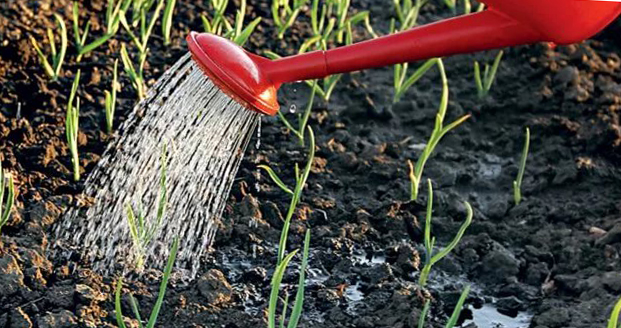
In the middle of summer, farmers can see that well-irrigated and well-groomed garlic shoots lose their vitality and turn yellow. This phenomenon indicates a lack of magnesium. You can compensate for the deficiency of this valuable mineral by adding a solution of magnesium sulfate (100-200 grams of dry matter per 10 liters of water). Similar symptoms occur when the culture is affected by nematodes. In this case, summer residents should arm themselves with simple table salt. With its strong solution, you need to wash the leaves of the plant and irrigate the soil around it.
Farmers striving for a quality crop need to know how to feed garlic in spring and autumn. This plant needs a large amount of organic matter, so the beds need to be prepared for planting in the fall by adding compost and humus flavored with ash to the soil. Also, when preparing beds for garlic, ready-made potash or phosphorus fertilizers and rotted manure can be used.
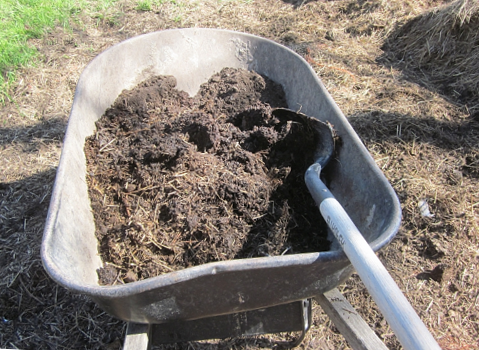 The introduction of humus in the garden
The introduction of humus in the garden In the spring, farmers must make at least three top dressings. At the same time, the period of fertilizing differs for winter and spring crops. In particular, in the spring, the winter plant will experience a deficiency of minerals, so a week after the snow melts, the summer resident will need to feed it for the first time. need the first top dressing after about 4-5 leaves form above the ground. Re-feeding of plants is carried out no earlier than two weeks after the first procedure.
The final dressing also has its own specifics. For spring and winter garlic, it is carried out at different times, so the farmer needs to monitor the degree of plant formation and individually select the date for fertilizing for them.
Depending on the stage of vegetative development, the nature of top dressing varies greatly. So, until the formation of cloves, the plant must be fed with nitrogen mixtures, and then with potassium-phosphorus solutions. It is best to bring them together with irrigation water.
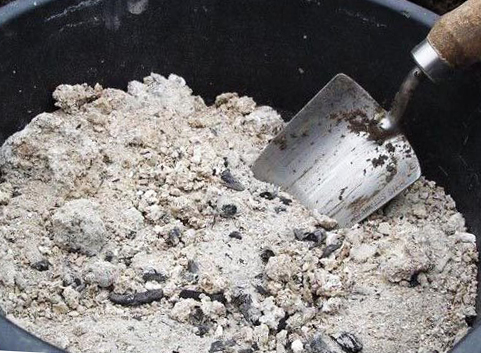 Ash for garlic and fertilizer, and disease prevention
Ash for garlic and fertilizer, and disease prevention In some cases, the introduction of bird droppings or a solution of urea into the soil is required. The fact that the time has come for such fertilizers, the farmer can recognize by the shrunken appearance of seedlings. Potassium fertilizer will help in the fight against clarification of garlic leaves, and if the plant turns yellow, you can use ammonium nitrate-based fertilizer.
Along with the root method of fertilizing, summer residents can practice foliar top dressing. They work as follows - when sprayed onto the leaves and stems of a plant, the nutrients from their composition are quickly absorbed and well absorbed. The foliar method is simple and effective, therefore it is widely used in many farms involved in the cultivation of onions and garlic.
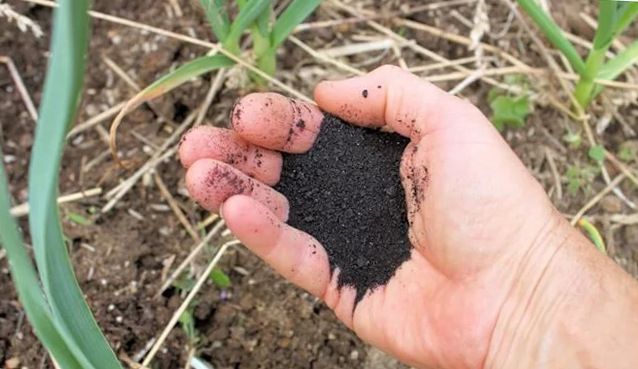 Foliar top dressing of garlic
Foliar top dressing of garlic Spraying garlic with fertilizer should not replace traditional top dressing. Its purpose is to supplement them and increase the efficiency of the supply of valuable nutrients to the plant. Spraying is recommended twice - during the period of active growth of garlic. It is better to choose cloudy, but dry days for the procedure.
Feeding winter garlic before winter, a summer resident may prefer organic and mineral fertilizers. Among them are:
- superphosphate;
- urea;
- potassium salt;
- combined fertilizers containing potassium, phosphorus and nitrogen;
- rotted mullein;
- slurry;
- ash, etc.
Despite the fact that the agricultural technology of growing onions and garlic is similar in many respects. Therefore, the feeding of these plants can be carried out in parallel, using the same fertilizers. In addition, identical concentrations of fertilizers are used for root and foliar feeding methods. But in order to get the best result, the farmer needs to monitor the condition of onion and garlic seedlings in the beds and promptly respond to signs indicating a deficiency of nutrients and minerals.